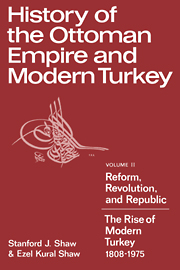Book contents
- Frontmatter
- Contents
- List of Tables
- Preface
- Preface to the second printing
- List of Abbreviations
- Note on Pronunciation
- Map of the Growth of the Ottoman Empire, 1280–1683
- Map of the Decline of the Ottoman Empire, 1683–1975
- 1 The Beginnings of Modern Ottoman Reform: The Era of Mahmut II, 1808–1839
- 2 The Era of Modern Reform: The Tanzimat, 1839–1876
- 3 Culmination of the Tanzimat: The Reign of Abdulhamit II, 1876–1909
- 4 The Young Turk Period, 1908–1918
- 5 The Turkish War for Independence, 1918–1923
- 6 The Turkish Republic, 1923–1975
- Appendix
- Bibliography: History of the Ottoman Empire and Modern Turkey, 1808–1975
- Index
Preface
Published online by Cambridge University Press: 20 May 2010
- Frontmatter
- Contents
- List of Tables
- Preface
- Preface to the second printing
- List of Abbreviations
- Note on Pronunciation
- Map of the Growth of the Ottoman Empire, 1280–1683
- Map of the Decline of the Ottoman Empire, 1683–1975
- 1 The Beginnings of Modern Ottoman Reform: The Era of Mahmut II, 1808–1839
- 2 The Era of Modern Reform: The Tanzimat, 1839–1876
- 3 Culmination of the Tanzimat: The Reign of Abdulhamit II, 1876–1909
- 4 The Young Turk Period, 1908–1918
- 5 The Turkish War for Independence, 1918–1923
- 6 The Turkish Republic, 1923–1975
- Appendix
- Bibliography: History of the Ottoman Empire and Modern Turkey, 1808–1975
- Index
Summary
During the nineteenth century the Ottoman Empire witnessed a sustained effort of reform that saw the long-preserved and honored institutions of the classical Ottoman state replaced by new ones, inspired by an increasing knowledge of European thought, society, and government and modified to satisfy Ottoman needs and conditions. In the process the scope of government was extended far beyond the limits imposed by the traditional Ottoman way into every aspect of life, overwhelming the autonomous religious, economic, and social groups that had survived for so long as the substrata of Ottoman society. A new, modern, westernized ruling bureaucracy replaced the old Ruling Class, extended its power throughout the empire, and created a highly complex system of government that ruled with an autocracy unmatched in traditional times.
The era of modern Ottoman reforms began in the last decade of the reign of Sultan Mahmut II (1808–1839), who laid the foundations for what followed. His work was extended and at least partially completed during the Tanzimat reform period, which encompassed the reigns of his sons Abdulmecit I (1839–1861) and Abdulaziz (1861–1876), and it was carried out by the reformist bureaucracy of the Men of the Tanzimat, led by able statesmen such as Mustafa Reşit Paşa, Âli Paşa, and Fuat Paşa.
Reform in the Ottoman Empire was a complex process; each solution created new problems. The application of new laws and practices was slowed for a number of reasons. First of all, the empire remained very large, with a heterogeneous society and relatively poor communications.
- Type
- Chapter
- Information
- History of the Ottoman Empire and Modern Turkey , pp. vii - ixPublisher: Cambridge University PressPrint publication year: 1977



